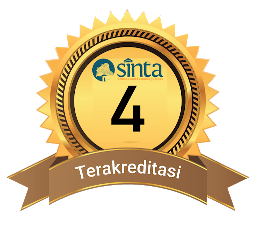Pengaruh Model Pembelajaran Berbasis Masalah dengan Media Lembar Kerja Terhadap Hasil Belajar Siswa SMA
DOI:
10.29303/cep.v2i1.1120Published:
2019-05-24Issue:
Vol. 2 No. 1 (2019): MeiArticles
Downloads
How to Cite
Abstract
Penelitian ini bertujuan untuk mendeskripsikan pengaruh model pembelajaran berbasis masalah terhadap hasil belajar kimia siswa kelas X SMA Negeri 1 Kediri pada materi konsep oksidasi reduksi. Penelitian eksperimen semu ini menggunakan desain kelompok kontrol non ekuivalen pretest-posttest. Populasi penelitian adalah 115 siswa kelas X yang terbagi dalam lima kelas. Dua kelas dipilih menjadi sampel dengan pertimbangan jumlah pertemuan yang sama, yaitu 5 pertemuan (5 x 3 jam pelajaran). Terpilih kelas A sebagai kelas eksperimen yang diberikan perlakuan berupa penerapan model pembelajaran berbasis masalah dengan bantuan lembar kerja siswa (LKS) berbasis masalah dan kelas X B sebagai kelas kontrol yang diajarkan dengan model pembelajaran langsung. Sebelum penerapan model dilakukan, kedua kelas diberikan pretest dengan soal essay dan diperoleh nilai rata-rata kelas eksperimen dan kelas kontrol secara berututan adalah 10,15 dan 13,49. Setelah diberikan perlakuan kedua kelas diberikan posttest dengan soal essay dan didapatkan nilai rata-rata kelas eksperimen dan kelas kontrol secara berurutan yaitu 47,84 dan 47,1. Data hasil belajar siswa (hasil tes) dianalisis dengan uji anacova dengan nilaiÃÂ pretest sebagai kovariat. Secara statistik disimpulkan bahwa penerapan model pembelajaran berbasis masalah dengan media lembar kerja berpengaruh terhadap hasil belajar kimia. Artikel ini menyajikan lebih lanjut penjelasan temuan hasil pengamatan pembelajaran yang mendukung data kuantitatif di atasReferences
Andayani, Y., Al-Idrus, S. W., & Purwoko, A. A. (2019). Penerapan Metode Praktikum Berbasis Kehidupan Sehari-hari Terhadap Keterampilan Proses Sains Siswa Kelas XI MIA MAN 1 Mataram. Chemistry Education Practice, 1(2), 20-26.
Graaff, E. and Anette, K. 2003. Characteristics of Problem Based Learning. International Journal. Engng Ed.19 (5). 34 - 47.
Gorghiu, Gabriel, Luminita, M., Sorin,C., Ana, M., Laura, M. 2015. Problem- Based Learning ââ¬â An Efficient Learning Strategy In The Science Lesson Context. Procedia- Social and Behavioral Sciences 191. 2015
Huang,H. 2005. Chinese International Studentsââ¬â¢ Perceptions of the Problem Based Learning Experience. Journal of Hospitality, Leusure, Sport and Tourism Education.4(2). 36 ââ¬â 43.
Jansson, S., H, Soderstrom., Andersson, P. L., dan Nording, M. L. 2015. Implementation of Problem Based Learning in Environmental Chemistry. Journal of Chemical Education. 5 (4). 35-46.
Laksmiwati, D., Hadisaputra, S., & Siahaan, J. (2019). Pengembangan Modul Praktikum Kimia Berbasis Problem Based Learning Untuk Kelas XI SMA. Chemistry Education Practice, 1(2), 36-41.
Magdalena,O., Mulyani, S., dan Susanti, E. 2014. Pengaruh Model Problem Based Learning dan Inquiri terhadap Prestasi Belajar Siswa Ditinjau dari Kreativitas Verbal pada Materi Hukum Dasar Kimia Kelas X SMAN 1 Boyolali Tahun Pelajaran 2013/2014. Jurnal Pendidikan Kimia. 3 (4).
Noordin, Muhammad,K., Ahmad,N., Dayana, F., Mohd S. 2011. Problem- Based Learning (PBL) and Project-Based Learning (PjBL) in Engineering Education: a Comparison. Proceeding of the IETECââ¬â¢11 Conference, Kuala Lumpur, Malaysia. 16-19 Januari 2011.
Putri, A. F. A., Utami, B., dan Nugroho, A. 2015. Penerapan Model Pembelajaran Problem Based Learning (PBL) Disertai Eksperimen untuk meningkatkan Interaksi Sosial dan Prestasi Belajar Siswa pada Materi Pokok Kelarutan dan Hasil Kali Kelarutan di SMA Muhammadiyah 1 Karanganyar Tahun Pelajran 2014/2015. Jurnal Pendidikan Kimia. 4 (4). 27-35
Selcuk, G.S. 2010. The Effect of Problem Based Learning on PreServis Teachersââ¬â¢ Achievement, Approaches and Attitudes towards Learning Physics. International Journal of Physical Sciences. 5 (6). 711-723.
Sugiyono. 2014. Metode penelitian Kuantitatif, Kuantitatif dan R & D. Bandung: Alfabeta.
Sumintono, B dan Widhiarso, W. 2015. Aplikasi Pemodelan Rasch pada Assessment Pendidikan. Cimahi: Trim Komunikata.
Author Biographies
Yuyum Fahmidani, Program Studi Pendidikan Kimia FKIP, Universitas Mataram
Yayuk Andayani, Program Studi Pendidikan Kimia, FKIP, Universitas Mataram
Januar Srikandijana, Program Studi Pendidikan Kimia, FKIP, Universitas Mataram
Agus Abhi Purwoko, Program Studi Pendidikan Kimia, FKIP, Universitas Mataram
License
Authors who publish with Chemistry Education Practice agree to the following terms:
- Authors retain copyright and grant the journal right of first publication with the work simultaneously licensed under a Creative Commons Attribution License 4.0 International License (CC-BY-SA License). This license allows authors to use all articles, data sets, graphics, and appendices in data mining applications, search engines, web sites, blogs, and other platforms by providing an appropriate reference. The journal allows the author(s) to hold the copyright without restrictions and will retain publishing rights without restrictions.
- Authors are able to enter into separate, additional contractual arrangements for the non-exclusive distribution of the journal's published version of the work (e.g., post it to an institutional repository or publish it in a book), with an acknowledgement of its initial publication in Chemistry Education Practice.
- Authors are permitted and encouraged to post their work online (e.g., in institutional repositories or on their website) prior to and during the submission process, as it can lead to productive exchanges, as well as earlier and greater citation of published work (See The Effect of Open Access).






